IMAT5262 Research Project Proposal: RFID Chip Implants and Ethics
VerifiedAdded on 2023/01/06
|30
|5725
|24
Project
AI Summary
This project proposal, submitted for the MSc Information Systems Management course IMAT5262 at De Montfort University, investigates the ethical implications of human-centric RFID chip implants. The proposal begins with an abstract outlining the core concerns, followed by a detailed background explaining the increasing use of RFID technology and its potential benefits, alongside the associated ethical challenges. The research questions focus on the applications and ethical issues of implantable RFID chips. A comprehensive literature review explores the technology's evolution, ethical considerations (such as data privacy, bodily integrity, and health concerns), and basic components of the chips. The methodology review discusses various research methods, including interviews, questionnaires, surveys, and case studies, with a justification for the chosen methodologies of interviews and surveys. The project plan, ethical considerations, consent forms, and pilot study questions are included. The proposal highlights key ethical concerns regarding data security, privacy, and potential health risks, and examines how employers and other organizations may use this technology. The proposal is a comprehensive exploration of the ethical landscape surrounding RFID chip implants.
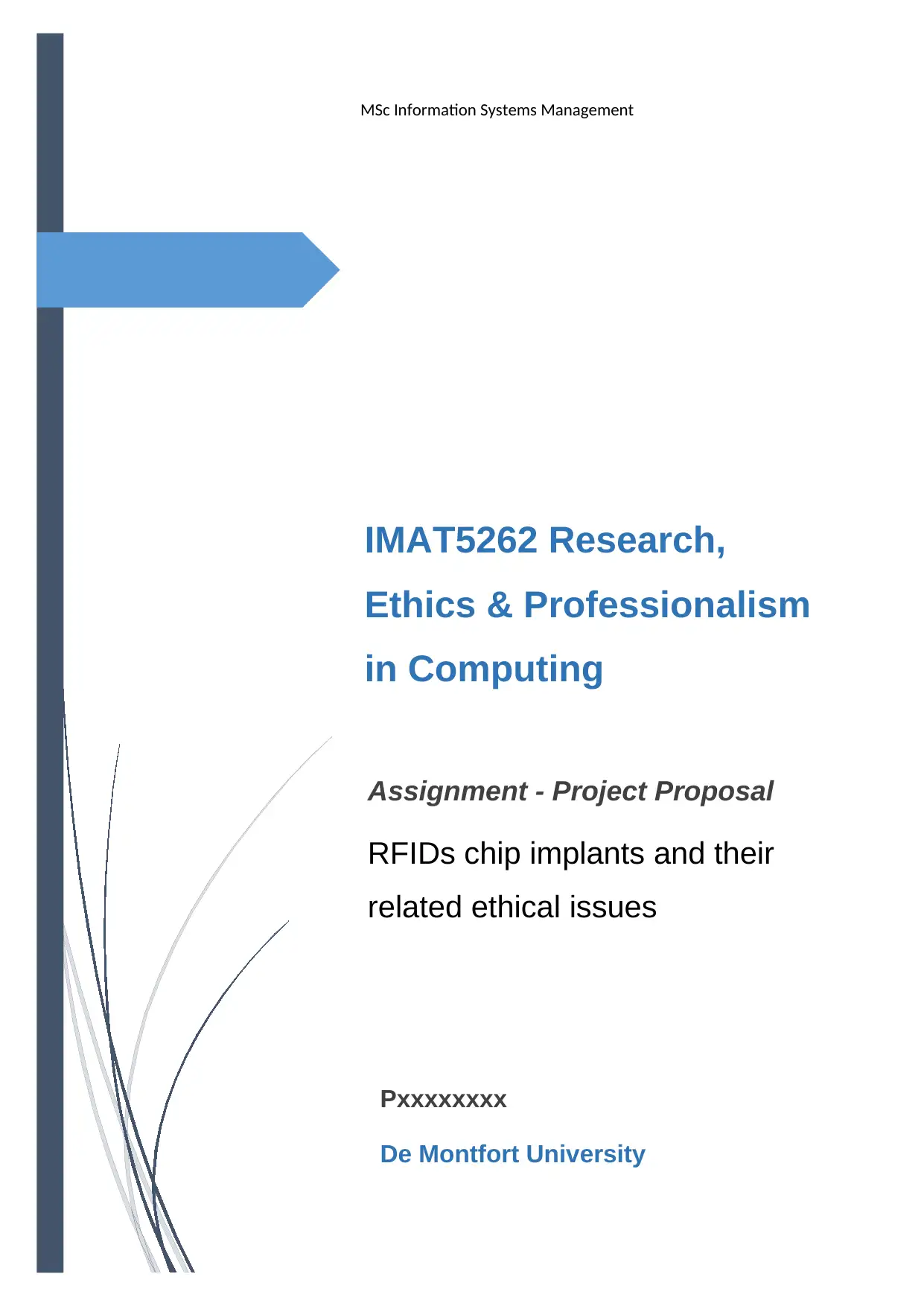
MSc Information Systems Management
IMAT5262 Research,
Ethics & Professionalism
in Computing
Assignment - Project Proposal
RFIDs chip implants and their
related ethical issues
Pxxxxxxxx
De Montfort University
IMAT5262 Research,
Ethics & Professionalism
in Computing
Assignment - Project Proposal
RFIDs chip implants and their
related ethical issues
Pxxxxxxxx
De Montfort University
Paraphrase This Document
Need a fresh take? Get an instant paraphrase of this document with our AI Paraphraser
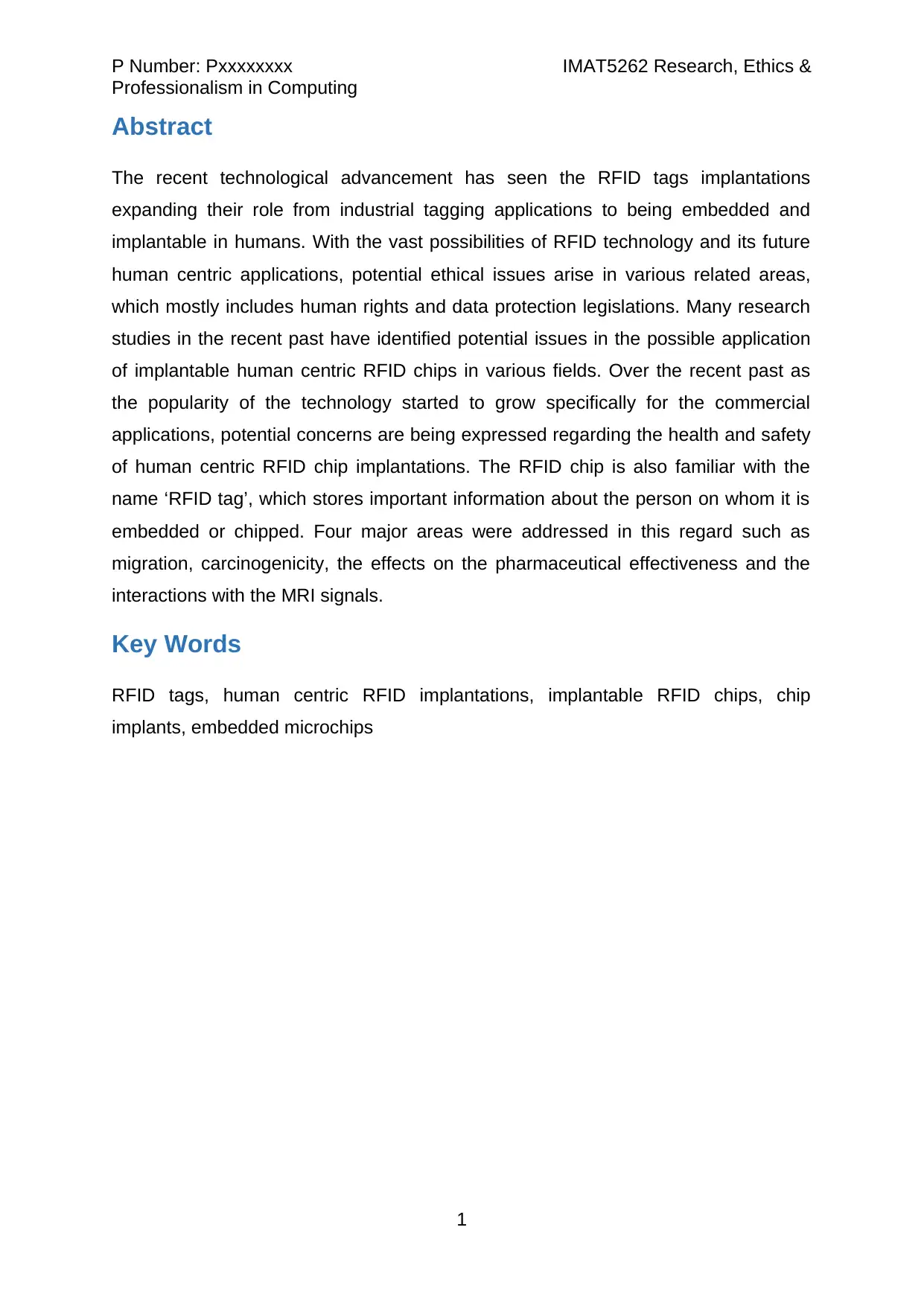
P Number: Pxxxxxxxx IMAT5262 Research, Ethics &
Professionalism in Computing
Abstract
The recent technological advancement has seen the RFID tags implantations
expanding their role from industrial tagging applications to being embedded and
implantable in humans. With the vast possibilities of RFID technology and its future
human centric applications, potential ethical issues arise in various related areas,
which mostly includes human rights and data protection legislations. Many research
studies in the recent past have identified potential issues in the possible application
of implantable human centric RFID chips in various fields. Over the recent past as
the popularity of the technology started to grow specifically for the commercial
applications, potential concerns are being expressed regarding the health and safety
of human centric RFID chip implantations. The RFID chip is also familiar with the
name ‘RFID tag’, which stores important information about the person on whom it is
embedded or chipped. Four major areas were addressed in this regard such as
migration, carcinogenicity, the effects on the pharmaceutical effectiveness and the
interactions with the MRI signals.
Key Words
RFID tags, human centric RFID implantations, implantable RFID chips, chip
implants, embedded microchips
1
Professionalism in Computing
Abstract
The recent technological advancement has seen the RFID tags implantations
expanding their role from industrial tagging applications to being embedded and
implantable in humans. With the vast possibilities of RFID technology and its future
human centric applications, potential ethical issues arise in various related areas,
which mostly includes human rights and data protection legislations. Many research
studies in the recent past have identified potential issues in the possible application
of implantable human centric RFID chips in various fields. Over the recent past as
the popularity of the technology started to grow specifically for the commercial
applications, potential concerns are being expressed regarding the health and safety
of human centric RFID chip implantations. The RFID chip is also familiar with the
name ‘RFID tag’, which stores important information about the person on whom it is
embedded or chipped. Four major areas were addressed in this regard such as
migration, carcinogenicity, the effects on the pharmaceutical effectiveness and the
interactions with the MRI signals.
Key Words
RFID tags, human centric RFID implantations, implantable RFID chips, chip
implants, embedded microchips
1
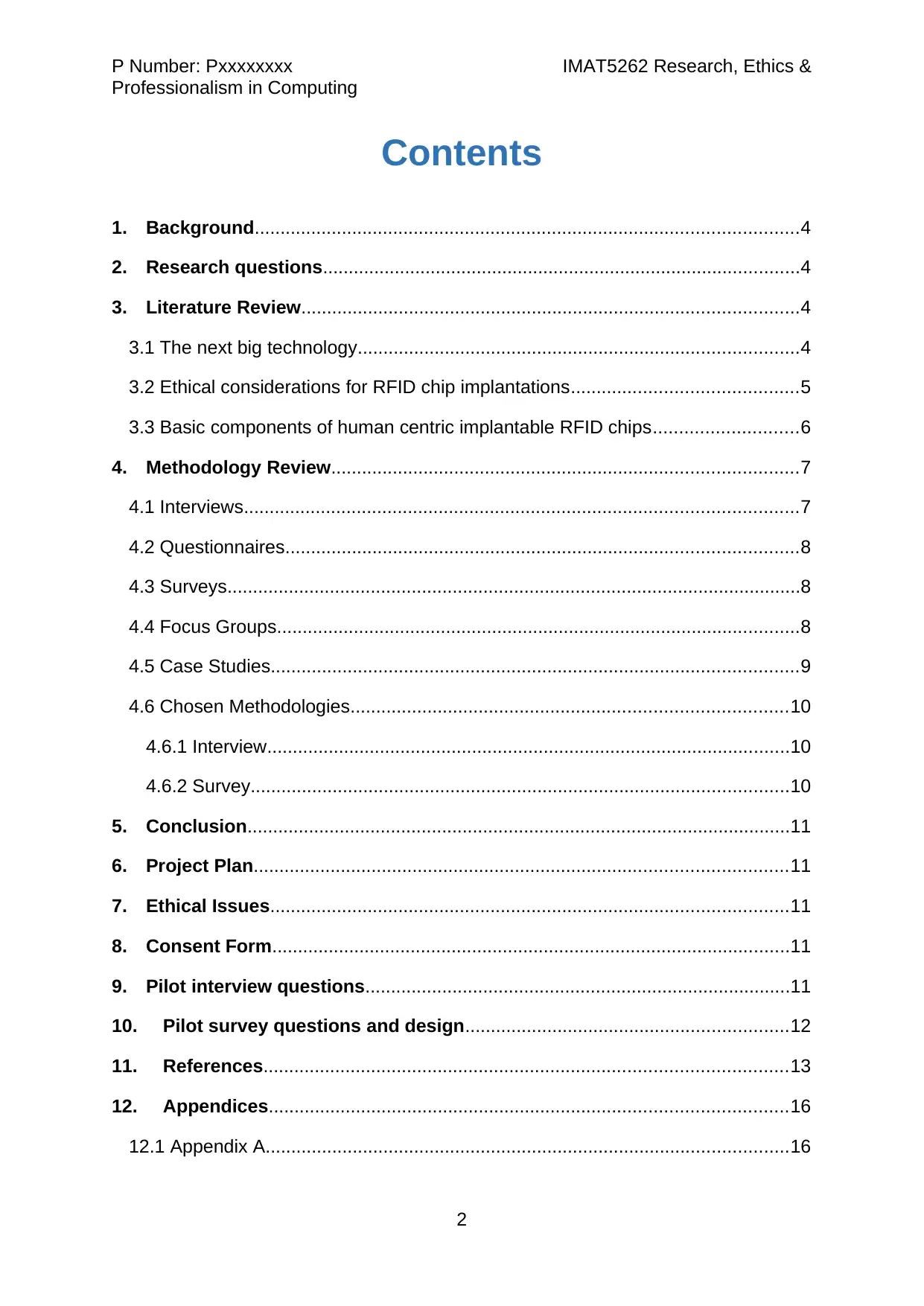
P Number: Pxxxxxxxx IMAT5262 Research, Ethics &
Professionalism in Computing
Contents
1. Background..........................................................................................................4
2. Research questions.............................................................................................4
3. Literature Review.................................................................................................4
3.1 The next big technology......................................................................................4
3.2 Ethical considerations for RFID chip implantations............................................5
3.3 Basic components of human centric implantable RFID chips............................6
4. Methodology Review...........................................................................................7
4.1 Interviews............................................................................................................7
4.2 Questionnaires....................................................................................................8
4.3 Surveys................................................................................................................8
4.4 Focus Groups......................................................................................................8
4.5 Case Studies.......................................................................................................9
4.6 Chosen Methodologies.....................................................................................10
4.6.1 Interview......................................................................................................10
4.6.2 Survey.........................................................................................................10
5. Conclusion..........................................................................................................11
6. Project Plan........................................................................................................11
7. Ethical Issues.....................................................................................................11
8. Consent Form.....................................................................................................11
9. Pilot interview questions...................................................................................11
10. Pilot survey questions and design...............................................................12
11. References......................................................................................................13
12. Appendices.....................................................................................................16
12.1 Appendix A......................................................................................................16
2
Professionalism in Computing
Contents
1. Background..........................................................................................................4
2. Research questions.............................................................................................4
3. Literature Review.................................................................................................4
3.1 The next big technology......................................................................................4
3.2 Ethical considerations for RFID chip implantations............................................5
3.3 Basic components of human centric implantable RFID chips............................6
4. Methodology Review...........................................................................................7
4.1 Interviews............................................................................................................7
4.2 Questionnaires....................................................................................................8
4.3 Surveys................................................................................................................8
4.4 Focus Groups......................................................................................................8
4.5 Case Studies.......................................................................................................9
4.6 Chosen Methodologies.....................................................................................10
4.6.1 Interview......................................................................................................10
4.6.2 Survey.........................................................................................................10
5. Conclusion..........................................................................................................11
6. Project Plan........................................................................................................11
7. Ethical Issues.....................................................................................................11
8. Consent Form.....................................................................................................11
9. Pilot interview questions...................................................................................11
10. Pilot survey questions and design...............................................................12
11. References......................................................................................................13
12. Appendices.....................................................................................................16
12.1 Appendix A......................................................................................................16
2
⊘ This is a preview!⊘
Do you want full access?
Subscribe today to unlock all pages.

Trusted by 1+ million students worldwide

P Number: Pxxxxxxxx IMAT5262 Research, Ethics &
Professionalism in Computing
12.2 Appendix B........................................................................................................0
12.3 Appendix C........................................................................................................5
12.4 Appendix D........................................................................................................8
12.5 Appendix E........................................................................................................9
3
Professionalism in Computing
12.2 Appendix B........................................................................................................0
12.3 Appendix C........................................................................................................5
12.4 Appendix D........................................................................................................8
12.5 Appendix E........................................................................................................9
3
Paraphrase This Document
Need a fresh take? Get an instant paraphrase of this document with our AI Paraphraser

P Number: Pxxxxxxxx IMAT5262 Research, Ethics &
Professionalism in Computing
1. Background
The use of RFID (Radio Frequency Identification) is increasing and we are already in
the path of using implantable RFID chips in humans. According to Ito, Takahashi and
Saito (2016), the amount of benefits from these implantable RFID chips will be
numerous and undeniable. These implantable RFID chips are potentially durable
with an approximate size of a grain of rice. However, these chips are potentially
capable of holding adequate information about several aspects of a human being,
including his identity, health, physiological character, and nationality as well as
security clearances. These RFID chips are embedded in a person’s body, which in
turn enables them to do a lot of work (Sarwar et al. 2018). For instance, the proximity
of the hand of a person can potentially unlock his or her front door, start his or her
car or even inform their emergency physicians about certain specific health
conditions of the patient. These implanted chips oh human contains all the
information about the person on which it is embedded and are always with that
person.
However, there is a potentially darker side of this advanced technology of
implantable RFID chips. In this context, Heffernan, Vetere and Chang (2017) has
suggested that this particular technology is capable of violating the privacy and
bodily integrity of the human beings on whom the RFID chip is implanted. Voas and
Kshetri (2017) says there should be much concern and awareness about whether a
human being would want to implant a foreign object in his or her arm only to do a job
or let physicians know about their health conditions. To be more precise, Tabasum et
al. (2018) suggested that, with the implantation of RFID chips in employees,
employers are now able to track whenever they leave office.
2. Research questions
What are the potential use of implantable RFID chips?
What are the ethical implications of human centric RFID chip implants?
4
Professionalism in Computing
1. Background
The use of RFID (Radio Frequency Identification) is increasing and we are already in
the path of using implantable RFID chips in humans. According to Ito, Takahashi and
Saito (2016), the amount of benefits from these implantable RFID chips will be
numerous and undeniable. These implantable RFID chips are potentially durable
with an approximate size of a grain of rice. However, these chips are potentially
capable of holding adequate information about several aspects of a human being,
including his identity, health, physiological character, and nationality as well as
security clearances. These RFID chips are embedded in a person’s body, which in
turn enables them to do a lot of work (Sarwar et al. 2018). For instance, the proximity
of the hand of a person can potentially unlock his or her front door, start his or her
car or even inform their emergency physicians about certain specific health
conditions of the patient. These implanted chips oh human contains all the
information about the person on which it is embedded and are always with that
person.
However, there is a potentially darker side of this advanced technology of
implantable RFID chips. In this context, Heffernan, Vetere and Chang (2017) has
suggested that this particular technology is capable of violating the privacy and
bodily integrity of the human beings on whom the RFID chip is implanted. Voas and
Kshetri (2017) says there should be much concern and awareness about whether a
human being would want to implant a foreign object in his or her arm only to do a job
or let physicians know about their health conditions. To be more precise, Tabasum et
al. (2018) suggested that, with the implantation of RFID chips in employees,
employers are now able to track whenever they leave office.
2. Research questions
What are the potential use of implantable RFID chips?
What are the ethical implications of human centric RFID chip implants?
4
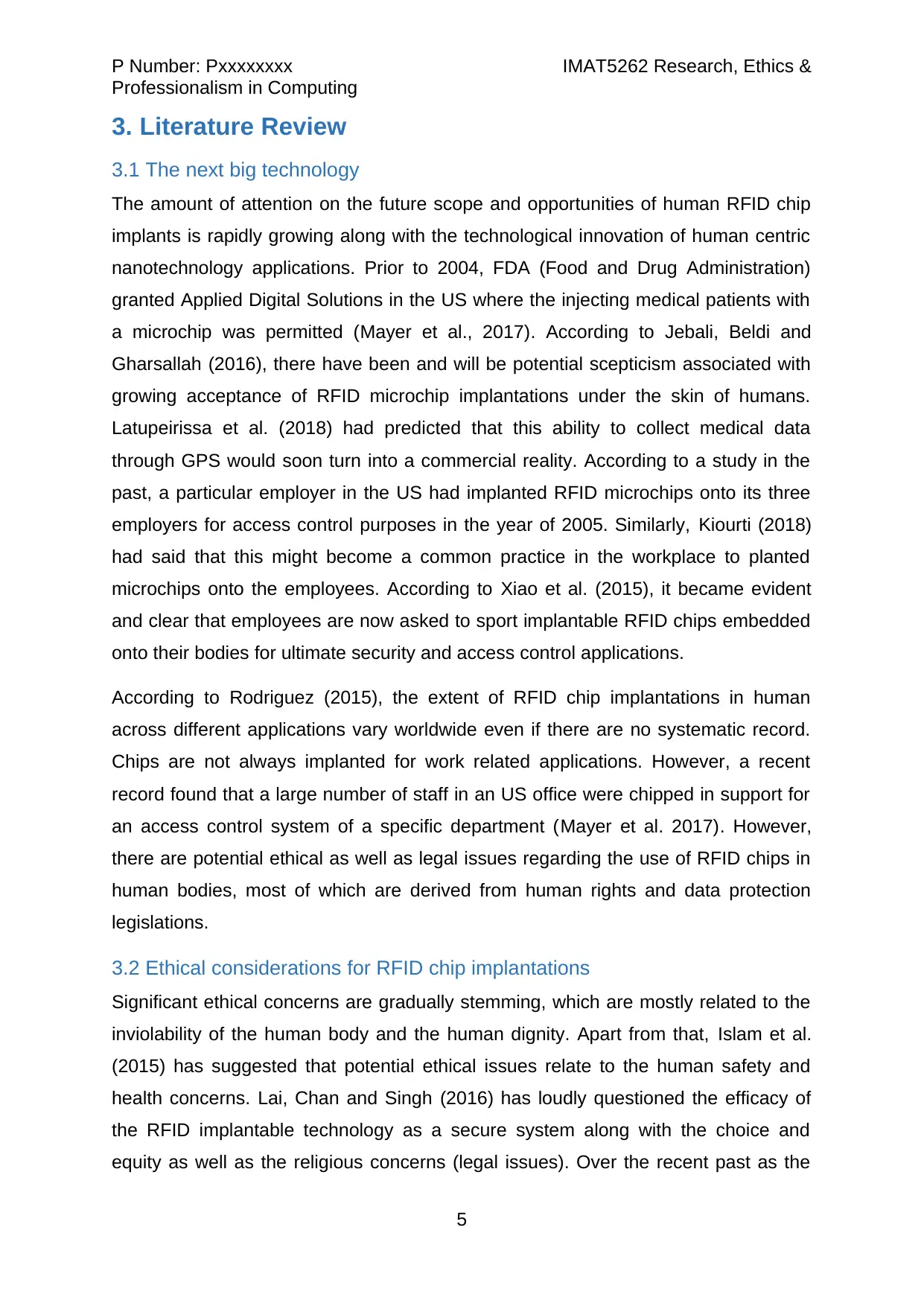
P Number: Pxxxxxxxx IMAT5262 Research, Ethics &
Professionalism in Computing
3. Literature Review
3.1 The next big technology
The amount of attention on the future scope and opportunities of human RFID chip
implants is rapidly growing along with the technological innovation of human centric
nanotechnology applications. Prior to 2004, FDA (Food and Drug Administration)
granted Applied Digital Solutions in the US where the injecting medical patients with
a microchip was permitted (Mayer et al., 2017). According to Jebali, Beldi and
Gharsallah (2016), there have been and will be potential scepticism associated with
growing acceptance of RFID microchip implantations under the skin of humans.
Latupeirissa et al. (2018) had predicted that this ability to collect medical data
through GPS would soon turn into a commercial reality. According to a study in the
past, a particular employer in the US had implanted RFID microchips onto its three
employers for access control purposes in the year of 2005. Similarly, Kiourti (2018)
had said that this might become a common practice in the workplace to planted
microchips onto the employees. According to Xiao et al. (2015), it became evident
and clear that employees are now asked to sport implantable RFID chips embedded
onto their bodies for ultimate security and access control applications.
According to Rodriguez (2015), the extent of RFID chip implantations in human
across different applications vary worldwide even if there are no systematic record.
Chips are not always implanted for work related applications. However, a recent
record found that a large number of staff in an US office were chipped in support for
an access control system of a specific department (Mayer et al. 2017). However,
there are potential ethical as well as legal issues regarding the use of RFID chips in
human bodies, most of which are derived from human rights and data protection
legislations.
3.2 Ethical considerations for RFID chip implantations
Significant ethical concerns are gradually stemming, which are mostly related to the
inviolability of the human body and the human dignity. Apart from that, Islam et al.
(2015) has suggested that potential ethical issues relate to the human safety and
health concerns. Lai, Chan and Singh (2016) has loudly questioned the efficacy of
the RFID implantable technology as a secure system along with the choice and
equity as well as the religious concerns (legal issues). Over the recent past as the
5
Professionalism in Computing
3. Literature Review
3.1 The next big technology
The amount of attention on the future scope and opportunities of human RFID chip
implants is rapidly growing along with the technological innovation of human centric
nanotechnology applications. Prior to 2004, FDA (Food and Drug Administration)
granted Applied Digital Solutions in the US where the injecting medical patients with
a microchip was permitted (Mayer et al., 2017). According to Jebali, Beldi and
Gharsallah (2016), there have been and will be potential scepticism associated with
growing acceptance of RFID microchip implantations under the skin of humans.
Latupeirissa et al. (2018) had predicted that this ability to collect medical data
through GPS would soon turn into a commercial reality. According to a study in the
past, a particular employer in the US had implanted RFID microchips onto its three
employers for access control purposes in the year of 2005. Similarly, Kiourti (2018)
had said that this might become a common practice in the workplace to planted
microchips onto the employees. According to Xiao et al. (2015), it became evident
and clear that employees are now asked to sport implantable RFID chips embedded
onto their bodies for ultimate security and access control applications.
According to Rodriguez (2015), the extent of RFID chip implantations in human
across different applications vary worldwide even if there are no systematic record.
Chips are not always implanted for work related applications. However, a recent
record found that a large number of staff in an US office were chipped in support for
an access control system of a specific department (Mayer et al. 2017). However,
there are potential ethical as well as legal issues regarding the use of RFID chips in
human bodies, most of which are derived from human rights and data protection
legislations.
3.2 Ethical considerations for RFID chip implantations
Significant ethical concerns are gradually stemming, which are mostly related to the
inviolability of the human body and the human dignity. Apart from that, Islam et al.
(2015) has suggested that potential ethical issues relate to the human safety and
health concerns. Lai, Chan and Singh (2016) has loudly questioned the efficacy of
the RFID implantable technology as a secure system along with the choice and
equity as well as the religious concerns (legal issues). Over the recent past as the
5
⊘ This is a preview!⊘
Do you want full access?
Subscribe today to unlock all pages.

Trusted by 1+ million students worldwide
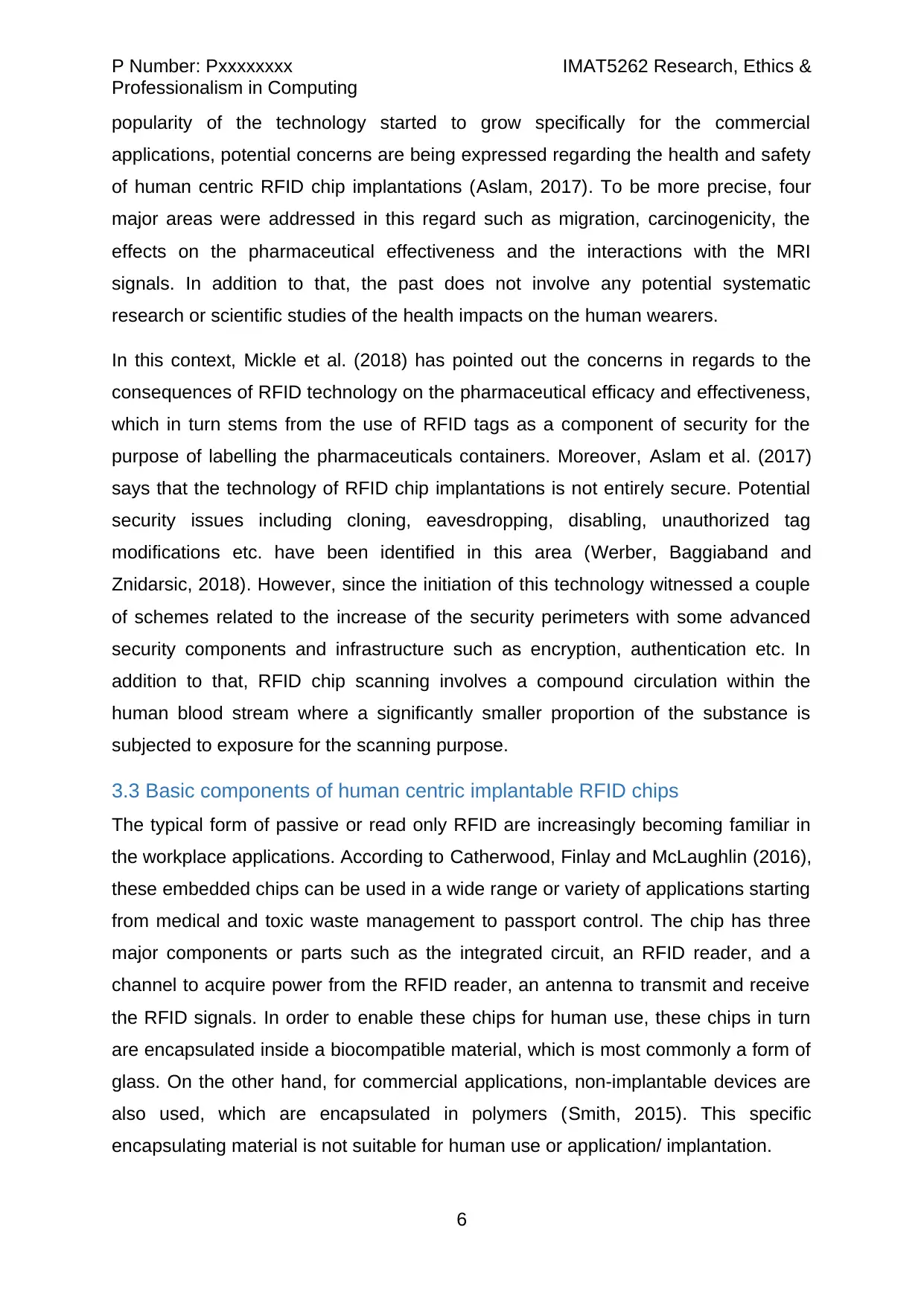
P Number: Pxxxxxxxx IMAT5262 Research, Ethics &
Professionalism in Computing
popularity of the technology started to grow specifically for the commercial
applications, potential concerns are being expressed regarding the health and safety
of human centric RFID chip implantations (Aslam, 2017). To be more precise, four
major areas were addressed in this regard such as migration, carcinogenicity, the
effects on the pharmaceutical effectiveness and the interactions with the MRI
signals. In addition to that, the past does not involve any potential systematic
research or scientific studies of the health impacts on the human wearers.
In this context, Mickle et al. (2018) has pointed out the concerns in regards to the
consequences of RFID technology on the pharmaceutical efficacy and effectiveness,
which in turn stems from the use of RFID tags as a component of security for the
purpose of labelling the pharmaceuticals containers. Moreover, Aslam et al. (2017)
says that the technology of RFID chip implantations is not entirely secure. Potential
security issues including cloning, eavesdropping, disabling, unauthorized tag
modifications etc. have been identified in this area (Werber, Baggiaband and
Znidarsic, 2018). However, since the initiation of this technology witnessed a couple
of schemes related to the increase of the security perimeters with some advanced
security components and infrastructure such as encryption, authentication etc. In
addition to that, RFID chip scanning involves a compound circulation within the
human blood stream where a significantly smaller proportion of the substance is
subjected to exposure for the scanning purpose.
3.3 Basic components of human centric implantable RFID chips
The typical form of passive or read only RFID are increasingly becoming familiar in
the workplace applications. According to Catherwood, Finlay and McLaughlin (2016),
these embedded chips can be used in a wide range or variety of applications starting
from medical and toxic waste management to passport control. The chip has three
major components or parts such as the integrated circuit, an RFID reader, and a
channel to acquire power from the RFID reader, an antenna to transmit and receive
the RFID signals. In order to enable these chips for human use, these chips in turn
are encapsulated inside a biocompatible material, which is most commonly a form of
glass. On the other hand, for commercial applications, non-implantable devices are
also used, which are encapsulated in polymers (Smith, 2015). This specific
encapsulating material is not suitable for human use or application/ implantation.
6
Professionalism in Computing
popularity of the technology started to grow specifically for the commercial
applications, potential concerns are being expressed regarding the health and safety
of human centric RFID chip implantations (Aslam, 2017). To be more precise, four
major areas were addressed in this regard such as migration, carcinogenicity, the
effects on the pharmaceutical effectiveness and the interactions with the MRI
signals. In addition to that, the past does not involve any potential systematic
research or scientific studies of the health impacts on the human wearers.
In this context, Mickle et al. (2018) has pointed out the concerns in regards to the
consequences of RFID technology on the pharmaceutical efficacy and effectiveness,
which in turn stems from the use of RFID tags as a component of security for the
purpose of labelling the pharmaceuticals containers. Moreover, Aslam et al. (2017)
says that the technology of RFID chip implantations is not entirely secure. Potential
security issues including cloning, eavesdropping, disabling, unauthorized tag
modifications etc. have been identified in this area (Werber, Baggiaband and
Znidarsic, 2018). However, since the initiation of this technology witnessed a couple
of schemes related to the increase of the security perimeters with some advanced
security components and infrastructure such as encryption, authentication etc. In
addition to that, RFID chip scanning involves a compound circulation within the
human blood stream where a significantly smaller proportion of the substance is
subjected to exposure for the scanning purpose.
3.3 Basic components of human centric implantable RFID chips
The typical form of passive or read only RFID are increasingly becoming familiar in
the workplace applications. According to Catherwood, Finlay and McLaughlin (2016),
these embedded chips can be used in a wide range or variety of applications starting
from medical and toxic waste management to passport control. The chip has three
major components or parts such as the integrated circuit, an RFID reader, and a
channel to acquire power from the RFID reader, an antenna to transmit and receive
the RFID signals. In order to enable these chips for human use, these chips in turn
are encapsulated inside a biocompatible material, which is most commonly a form of
glass. On the other hand, for commercial applications, non-implantable devices are
also used, which are encapsulated in polymers (Smith, 2015). This specific
encapsulating material is not suitable for human use or application/ implantation.
6
Paraphrase This Document
Need a fresh take? Get an instant paraphrase of this document with our AI Paraphraser

P Number: Pxxxxxxxx IMAT5262 Research, Ethics &
Professionalism in Computing
The RFID chip is also familiar with the name ‘RFID tag’, which stores important
information about the person on whom it is embedded or chipped. This chip is
responsible for sending the stored information back to the RFID reader at the time a
frequency (signal) is sent to the chip by the reader. These chips act as transponders
(both a responder and a transmitter) (Mihovska and Sarkar, 2018). The passive
RFID chips receive electrical energy from the electromagnetic waves that the reader
emits. On the contrary, the active RFID chips usually have their own battery with a
specified or limited life. These chips have their own antennas. Finally, a computer
(also known as a controller or a host) is responsible for controlling or managing the
RFID reader using software functions and operations (Patel, 2018). The controller is
subjected to processing the information as received from the network in order to
enable the operator to take the right decision.
4. Methodology Review
A research project may follow various different approaches in order to able to answer
the research questions in a successful manner. The research approaches can be
categorized into two individual types or techniques such as the qualitative and the
quantitative technique. For instance, these methodologies may include interviews,
surveys or questionnaires (Michael, 2016). These methodologies have their own
drawbacks and advantages. Hence, it is a crucial job for a researcher to select the
best suited research method and a research approach that is the most appropriate in
accordance with the nature of the study and the type of information that needs to be
collected.
4.1 Interviews
Interviewing is an example of qualitative data collection method that collects relevant
descriptive data from a comparatively smaller group of people. The collected
information usually covers broader range of areas and aspects related to a particular
topic. There are three basic types of interviews such as structured, semi structured
and unstructured interviews. The structured interviews are more similar and can be
compared to the questionnaire. According to Brannen (2017), this particular research
technique is the net of qualitative data collection in social research.
The primary benefit of interviews is that, it offers a thorough description along with an
in depth analysis of the subject or topic of concern. Moreover, it does not limit the
7
Professionalism in Computing
The RFID chip is also familiar with the name ‘RFID tag’, which stores important
information about the person on whom it is embedded or chipped. This chip is
responsible for sending the stored information back to the RFID reader at the time a
frequency (signal) is sent to the chip by the reader. These chips act as transponders
(both a responder and a transmitter) (Mihovska and Sarkar, 2018). The passive
RFID chips receive electrical energy from the electromagnetic waves that the reader
emits. On the contrary, the active RFID chips usually have their own battery with a
specified or limited life. These chips have their own antennas. Finally, a computer
(also known as a controller or a host) is responsible for controlling or managing the
RFID reader using software functions and operations (Patel, 2018). The controller is
subjected to processing the information as received from the network in order to
enable the operator to take the right decision.
4. Methodology Review
A research project may follow various different approaches in order to able to answer
the research questions in a successful manner. The research approaches can be
categorized into two individual types or techniques such as the qualitative and the
quantitative technique. For instance, these methodologies may include interviews,
surveys or questionnaires (Michael, 2016). These methodologies have their own
drawbacks and advantages. Hence, it is a crucial job for a researcher to select the
best suited research method and a research approach that is the most appropriate in
accordance with the nature of the study and the type of information that needs to be
collected.
4.1 Interviews
Interviewing is an example of qualitative data collection method that collects relevant
descriptive data from a comparatively smaller group of people. The collected
information usually covers broader range of areas and aspects related to a particular
topic. There are three basic types of interviews such as structured, semi structured
and unstructured interviews. The structured interviews are more similar and can be
compared to the questionnaire. According to Brannen (2017), this particular research
technique is the net of qualitative data collection in social research.
The primary benefit of interviews is that, it offers a thorough description along with an
in depth analysis of the subject or topic of concern. Moreover, it does not limit the
7
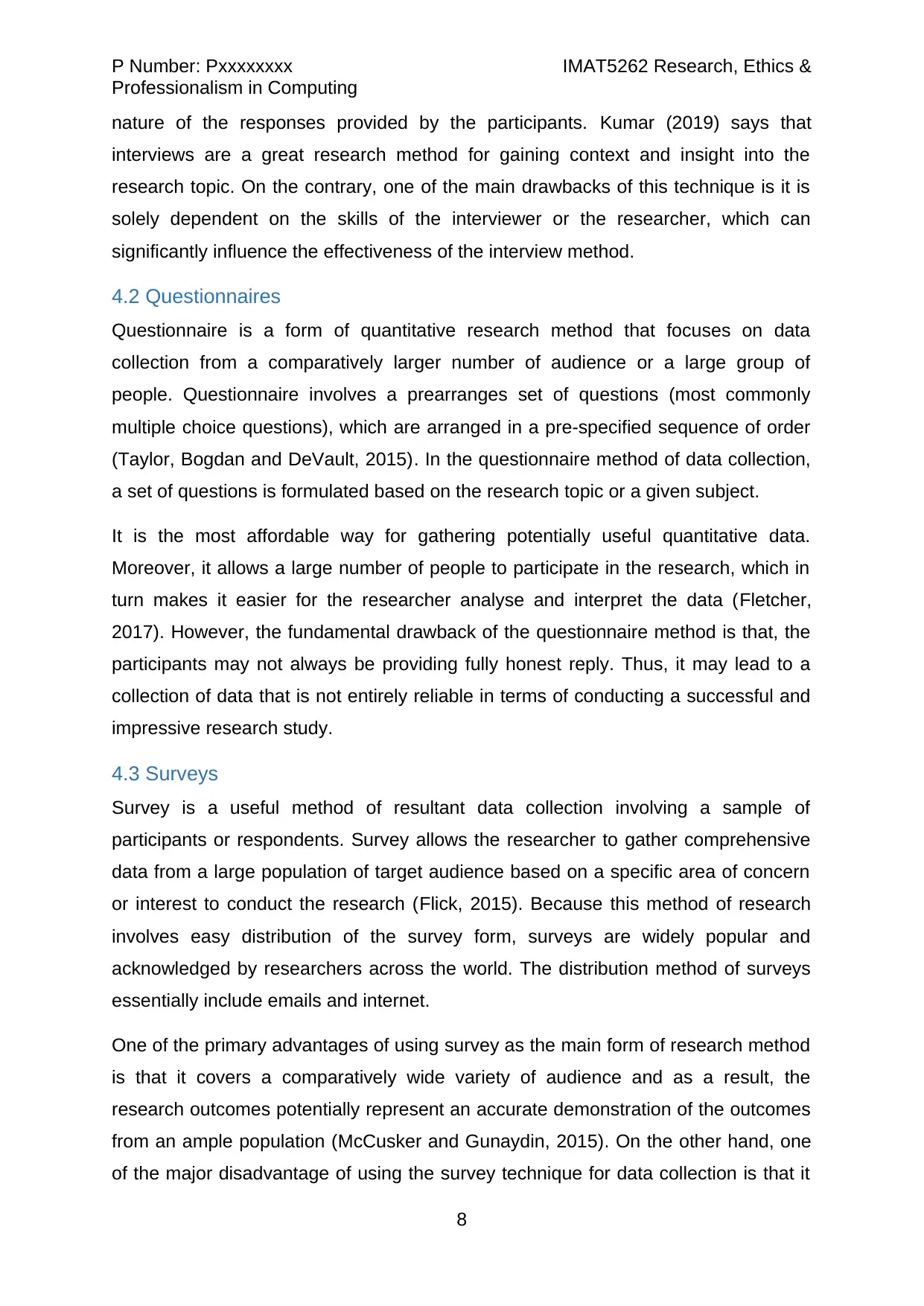
P Number: Pxxxxxxxx IMAT5262 Research, Ethics &
Professionalism in Computing
nature of the responses provided by the participants. Kumar (2019) says that
interviews are a great research method for gaining context and insight into the
research topic. On the contrary, one of the main drawbacks of this technique is it is
solely dependent on the skills of the interviewer or the researcher, which can
significantly influence the effectiveness of the interview method.
4.2 Questionnaires
Questionnaire is a form of quantitative research method that focuses on data
collection from a comparatively larger number of audience or a large group of
people. Questionnaire involves a prearranges set of questions (most commonly
multiple choice questions), which are arranged in a pre-specified sequence of order
(Taylor, Bogdan and DeVault, 2015). In the questionnaire method of data collection,
a set of questions is formulated based on the research topic or a given subject.
It is the most affordable way for gathering potentially useful quantitative data.
Moreover, it allows a large number of people to participate in the research, which in
turn makes it easier for the researcher analyse and interpret the data (Fletcher,
2017). However, the fundamental drawback of the questionnaire method is that, the
participants may not always be providing fully honest reply. Thus, it may lead to a
collection of data that is not entirely reliable in terms of conducting a successful and
impressive research study.
4.3 Surveys
Survey is a useful method of resultant data collection involving a sample of
participants or respondents. Survey allows the researcher to gather comprehensive
data from a large population of target audience based on a specific area of concern
or interest to conduct the research (Flick, 2015). Because this method of research
involves easy distribution of the survey form, surveys are widely popular and
acknowledged by researchers across the world. The distribution method of surveys
essentially include emails and internet.
One of the primary advantages of using survey as the main form of research method
is that it covers a comparatively wide variety of audience and as a result, the
research outcomes potentially represent an accurate demonstration of the outcomes
from an ample population (McCusker and Gunaydin, 2015). On the other hand, one
of the major disadvantage of using the survey technique for data collection is that it
8
Professionalism in Computing
nature of the responses provided by the participants. Kumar (2019) says that
interviews are a great research method for gaining context and insight into the
research topic. On the contrary, one of the main drawbacks of this technique is it is
solely dependent on the skills of the interviewer or the researcher, which can
significantly influence the effectiveness of the interview method.
4.2 Questionnaires
Questionnaire is a form of quantitative research method that focuses on data
collection from a comparatively larger number of audience or a large group of
people. Questionnaire involves a prearranges set of questions (most commonly
multiple choice questions), which are arranged in a pre-specified sequence of order
(Taylor, Bogdan and DeVault, 2015). In the questionnaire method of data collection,
a set of questions is formulated based on the research topic or a given subject.
It is the most affordable way for gathering potentially useful quantitative data.
Moreover, it allows a large number of people to participate in the research, which in
turn makes it easier for the researcher analyse and interpret the data (Fletcher,
2017). However, the fundamental drawback of the questionnaire method is that, the
participants may not always be providing fully honest reply. Thus, it may lead to a
collection of data that is not entirely reliable in terms of conducting a successful and
impressive research study.
4.3 Surveys
Survey is a useful method of resultant data collection involving a sample of
participants or respondents. Survey allows the researcher to gather comprehensive
data from a large population of target audience based on a specific area of concern
or interest to conduct the research (Flick, 2015). Because this method of research
involves easy distribution of the survey form, surveys are widely popular and
acknowledged by researchers across the world. The distribution method of surveys
essentially include emails and internet.
One of the primary advantages of using survey as the main form of research method
is that it covers a comparatively wide variety of audience and as a result, the
research outcomes potentially represent an accurate demonstration of the outcomes
from an ample population (McCusker and Gunaydin, 2015). On the other hand, one
of the major disadvantage of using the survey technique for data collection is that it
8
⊘ This is a preview!⊘
Do you want full access?
Subscribe today to unlock all pages.

Trusted by 1+ million students worldwide
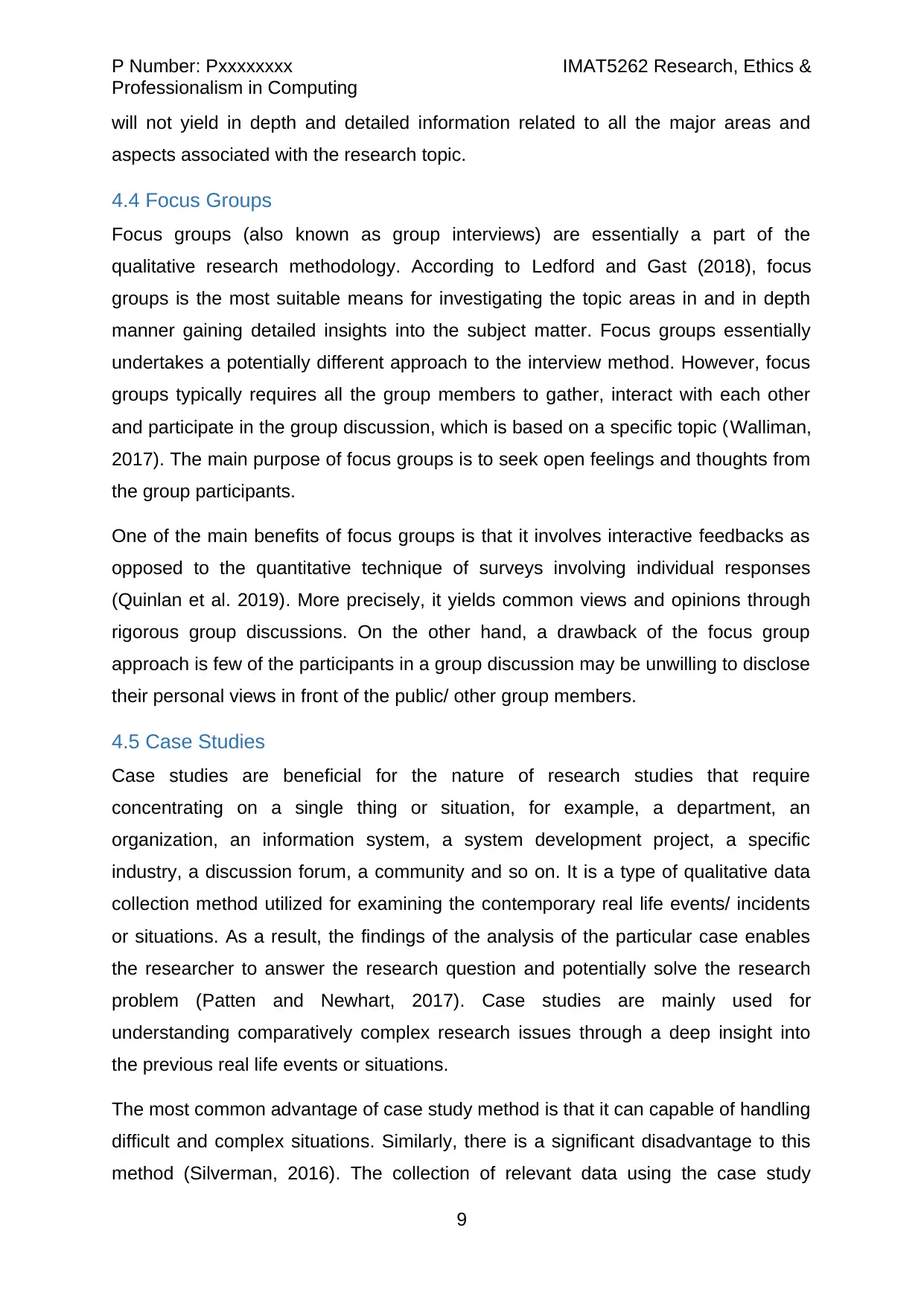
P Number: Pxxxxxxxx IMAT5262 Research, Ethics &
Professionalism in Computing
will not yield in depth and detailed information related to all the major areas and
aspects associated with the research topic.
4.4 Focus Groups
Focus groups (also known as group interviews) are essentially a part of the
qualitative research methodology. According to Ledford and Gast (2018), focus
groups is the most suitable means for investigating the topic areas in and in depth
manner gaining detailed insights into the subject matter. Focus groups essentially
undertakes a potentially different approach to the interview method. However, focus
groups typically requires all the group members to gather, interact with each other
and participate in the group discussion, which is based on a specific topic (Walliman,
2017). The main purpose of focus groups is to seek open feelings and thoughts from
the group participants.
One of the main benefits of focus groups is that it involves interactive feedbacks as
opposed to the quantitative technique of surveys involving individual responses
(Quinlan et al. 2019). More precisely, it yields common views and opinions through
rigorous group discussions. On the other hand, a drawback of the focus group
approach is few of the participants in a group discussion may be unwilling to disclose
their personal views in front of the public/ other group members.
4.5 Case Studies
Case studies are beneficial for the nature of research studies that require
concentrating on a single thing or situation, for example, a department, an
organization, an information system, a system development project, a specific
industry, a discussion forum, a community and so on. It is a type of qualitative data
collection method utilized for examining the contemporary real life events/ incidents
or situations. As a result, the findings of the analysis of the particular case enables
the researcher to answer the research question and potentially solve the research
problem (Patten and Newhart, 2017). Case studies are mainly used for
understanding comparatively complex research issues through a deep insight into
the previous real life events or situations.
The most common advantage of case study method is that it can capable of handling
difficult and complex situations. Similarly, there is a significant disadvantage to this
method (Silverman, 2016). The collection of relevant data using the case study
9
Professionalism in Computing
will not yield in depth and detailed information related to all the major areas and
aspects associated with the research topic.
4.4 Focus Groups
Focus groups (also known as group interviews) are essentially a part of the
qualitative research methodology. According to Ledford and Gast (2018), focus
groups is the most suitable means for investigating the topic areas in and in depth
manner gaining detailed insights into the subject matter. Focus groups essentially
undertakes a potentially different approach to the interview method. However, focus
groups typically requires all the group members to gather, interact with each other
and participate in the group discussion, which is based on a specific topic (Walliman,
2017). The main purpose of focus groups is to seek open feelings and thoughts from
the group participants.
One of the main benefits of focus groups is that it involves interactive feedbacks as
opposed to the quantitative technique of surveys involving individual responses
(Quinlan et al. 2019). More precisely, it yields common views and opinions through
rigorous group discussions. On the other hand, a drawback of the focus group
approach is few of the participants in a group discussion may be unwilling to disclose
their personal views in front of the public/ other group members.
4.5 Case Studies
Case studies are beneficial for the nature of research studies that require
concentrating on a single thing or situation, for example, a department, an
organization, an information system, a system development project, a specific
industry, a discussion forum, a community and so on. It is a type of qualitative data
collection method utilized for examining the contemporary real life events/ incidents
or situations. As a result, the findings of the analysis of the particular case enables
the researcher to answer the research question and potentially solve the research
problem (Patten and Newhart, 2017). Case studies are mainly used for
understanding comparatively complex research issues through a deep insight into
the previous real life events or situations.
The most common advantage of case study method is that it can capable of handling
difficult and complex situations. Similarly, there is a significant disadvantage to this
method (Silverman, 2016). The collection of relevant data using the case study
9
Paraphrase This Document
Need a fresh take? Get an instant paraphrase of this document with our AI Paraphraser
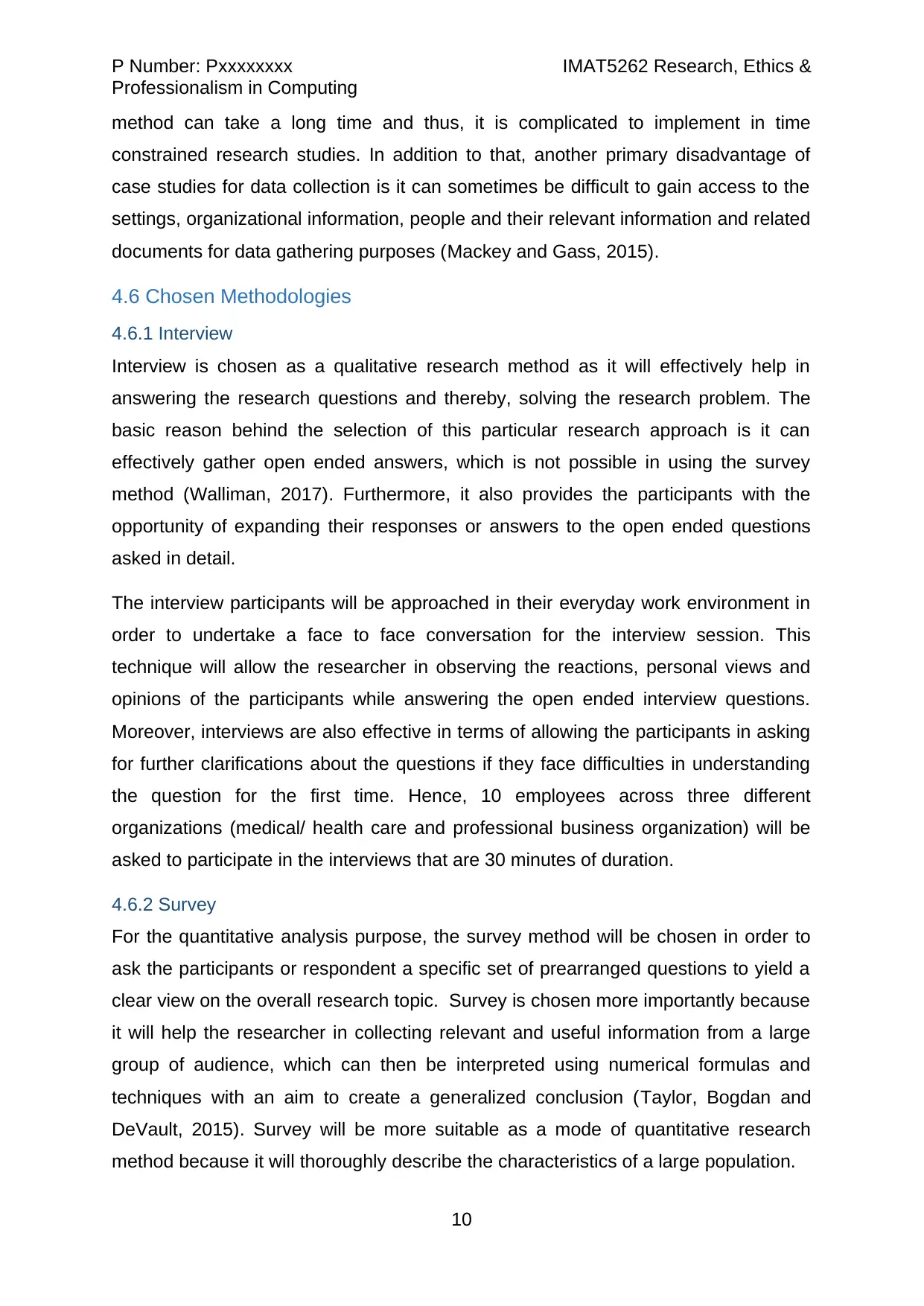
P Number: Pxxxxxxxx IMAT5262 Research, Ethics &
Professionalism in Computing
method can take a long time and thus, it is complicated to implement in time
constrained research studies. In addition to that, another primary disadvantage of
case studies for data collection is it can sometimes be difficult to gain access to the
settings, organizational information, people and their relevant information and related
documents for data gathering purposes (Mackey and Gass, 2015).
4.6 Chosen Methodologies
4.6.1 Interview
Interview is chosen as a qualitative research method as it will effectively help in
answering the research questions and thereby, solving the research problem. The
basic reason behind the selection of this particular research approach is it can
effectively gather open ended answers, which is not possible in using the survey
method (Walliman, 2017). Furthermore, it also provides the participants with the
opportunity of expanding their responses or answers to the open ended questions
asked in detail.
The interview participants will be approached in their everyday work environment in
order to undertake a face to face conversation for the interview session. This
technique will allow the researcher in observing the reactions, personal views and
opinions of the participants while answering the open ended interview questions.
Moreover, interviews are also effective in terms of allowing the participants in asking
for further clarifications about the questions if they face difficulties in understanding
the question for the first time. Hence, 10 employees across three different
organizations (medical/ health care and professional business organization) will be
asked to participate in the interviews that are 30 minutes of duration.
4.6.2 Survey
For the quantitative analysis purpose, the survey method will be chosen in order to
ask the participants or respondent a specific set of prearranged questions to yield a
clear view on the overall research topic. Survey is chosen more importantly because
it will help the researcher in collecting relevant and useful information from a large
group of audience, which can then be interpreted using numerical formulas and
techniques with an aim to create a generalized conclusion (Taylor, Bogdan and
DeVault, 2015). Survey will be more suitable as a mode of quantitative research
method because it will thoroughly describe the characteristics of a large population.
10
Professionalism in Computing
method can take a long time and thus, it is complicated to implement in time
constrained research studies. In addition to that, another primary disadvantage of
case studies for data collection is it can sometimes be difficult to gain access to the
settings, organizational information, people and their relevant information and related
documents for data gathering purposes (Mackey and Gass, 2015).
4.6 Chosen Methodologies
4.6.1 Interview
Interview is chosen as a qualitative research method as it will effectively help in
answering the research questions and thereby, solving the research problem. The
basic reason behind the selection of this particular research approach is it can
effectively gather open ended answers, which is not possible in using the survey
method (Walliman, 2017). Furthermore, it also provides the participants with the
opportunity of expanding their responses or answers to the open ended questions
asked in detail.
The interview participants will be approached in their everyday work environment in
order to undertake a face to face conversation for the interview session. This
technique will allow the researcher in observing the reactions, personal views and
opinions of the participants while answering the open ended interview questions.
Moreover, interviews are also effective in terms of allowing the participants in asking
for further clarifications about the questions if they face difficulties in understanding
the question for the first time. Hence, 10 employees across three different
organizations (medical/ health care and professional business organization) will be
asked to participate in the interviews that are 30 minutes of duration.
4.6.2 Survey
For the quantitative analysis purpose, the survey method will be chosen in order to
ask the participants or respondent a specific set of prearranged questions to yield a
clear view on the overall research topic. Survey is chosen more importantly because
it will help the researcher in collecting relevant and useful information from a large
group of audience, which can then be interpreted using numerical formulas and
techniques with an aim to create a generalized conclusion (Taylor, Bogdan and
DeVault, 2015). Survey will be more suitable as a mode of quantitative research
method because it will thoroughly describe the characteristics of a large population.
10

P Number: Pxxxxxxxx IMAT5262 Research, Ethics &
Professionalism in Computing
Therefore, survey will be a quick and time saving approach to collect information via
online survey forms involving a selected population of samples. In this study, 100
employees from two different organizations (one health care organization and
another IT organization) will be asked to participate in the survey through email.
They will require filling up the survey form and submit it online. Then, the gathered
responses will be analysed using numerical mechanisms.
5. Conclusion
RFID chips are embedded in a person’s body, which in turn enables them to do a lot
of work. For instance, the proximity of the hand of a person can potentially unlock his
or her front door, start his or her car or even inform their emergency physicians
about certain specific health conditions of the patient. Significant ethical concerns
regarding the use of human centric implantable RFID tags/ chips are gradually
stemming and they are mostly related to the inviolability of the human body and the
human dignity. Most of the potential ethical issues highly relate to the legislative,
human safety and health concerns.
6. Project Plan
Please refer to Appendix A in the Appendices section to view the Gantt chart; here
you will see the research project is broken down in tasks with appropriate dates set
for the timescale and completion of each task.
7. Ethical Issues
Possible ethical issues can arise from a research project that involves humans as
participants; therefore an Ethical Review Form is provided Appendix B stating the
possible ethical issues related to this research project.
8. Consent Form
As data about participants will be gathered and used to answer the research
question. Therefore, each participant taking part will be provided a consent form
which need to sign in order to take part in the research activity. Please refer to
Appendix C in the Appendices section to view a copy of the consent form.
11
Professionalism in Computing
Therefore, survey will be a quick and time saving approach to collect information via
online survey forms involving a selected population of samples. In this study, 100
employees from two different organizations (one health care organization and
another IT organization) will be asked to participate in the survey through email.
They will require filling up the survey form and submit it online. Then, the gathered
responses will be analysed using numerical mechanisms.
5. Conclusion
RFID chips are embedded in a person’s body, which in turn enables them to do a lot
of work. For instance, the proximity of the hand of a person can potentially unlock his
or her front door, start his or her car or even inform their emergency physicians
about certain specific health conditions of the patient. Significant ethical concerns
regarding the use of human centric implantable RFID tags/ chips are gradually
stemming and they are mostly related to the inviolability of the human body and the
human dignity. Most of the potential ethical issues highly relate to the legislative,
human safety and health concerns.
6. Project Plan
Please refer to Appendix A in the Appendices section to view the Gantt chart; here
you will see the research project is broken down in tasks with appropriate dates set
for the timescale and completion of each task.
7. Ethical Issues
Possible ethical issues can arise from a research project that involves humans as
participants; therefore an Ethical Review Form is provided Appendix B stating the
possible ethical issues related to this research project.
8. Consent Form
As data about participants will be gathered and used to answer the research
question. Therefore, each participant taking part will be provided a consent form
which need to sign in order to take part in the research activity. Please refer to
Appendix C in the Appendices section to view a copy of the consent form.
11
⊘ This is a preview!⊘
Do you want full access?
Subscribe today to unlock all pages.

Trusted by 1+ million students worldwide
1 out of 30
Related Documents
Your All-in-One AI-Powered Toolkit for Academic Success.
+13062052269
info@desklib.com
Available 24*7 on WhatsApp / Email
![[object Object]](/_next/static/media/star-bottom.7253800d.svg)
Unlock your academic potential
Copyright © 2020–2025 A2Z Services. All Rights Reserved. Developed and managed by ZUCOL.





